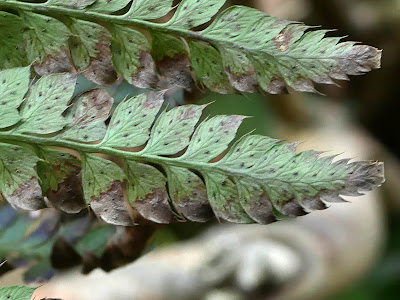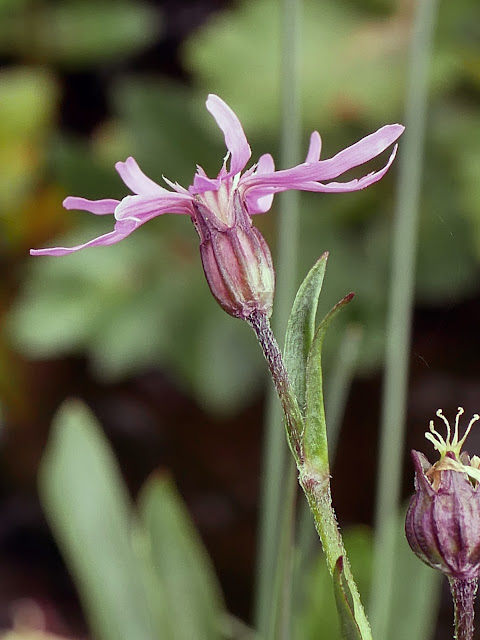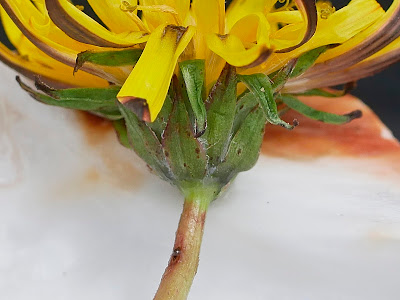As April begins, so does the Dandelion season. From now until early May is the time to seek out the daintier native Dandelions in your area and try and work out what species they are. The season is so short because as Spring marches on, the plants grow atypical leaves that have too much variation, thus making it extremely difficult to determine correctly. Bear in mind there are over 230 species of Dandelions and probably some still not named.
On a family outing to Minions on the Bodmin Moor, we looked around an old abandoned and ruined engine house and all around it were medium sized Dandelions that looked familiar. The Moor is hugely overgrazed and nothing much over an inch tall survives the sheep, ponies and cattle that roam around. However, by the ruined building was a recently installed fence and this had allowed a few Dandelions to grow a bit bigger. The key points with this species are that it had lots of pollen; discoloured stigmas and tips of the ligules; erect outer bracts ; 2-4 side lobes on the leaves, some of which were cucullate (shaped like a hood or having a hoodlike part.) I took a sample home and keyed it out to be:
Taraxacum britannicum
The BSBI Taraxacum referee agreed with my determination, which was great given it was the first one I had collected in some time.
Botany is not always about rare or threatened plants. In early April I found this amazing pink form of the common Daisy in a sandy car park at Harlyn Bay. These often have ray petals with pink undersides, but it is rare to find one with the upper side as pink as this one!
Bellis perennis
The first Bugle opening its flowers, a small group in east Cornwall on a roadside. Bees were all over it.
Ajuga reptans
Hairy Wood-rush all over the place in a woodland near St. Dominick, hopefully, better photos than in last month's blog.
Luzula pilosa
Some odd looking ferns caught my attention and a closer look at the fronds showed this to be the Hard Shield Fern, uncommon in Cornwall, but previously recorded from here. So it was good to update the old records for it.
Polystichum aculeatum
Bog Stitchwort with its tiny flowers, its petals deeply cut in two and shaped like a V. Found on a damp rural road verge.
Stellaria alsine
The flowers of the rather invasive Cherry Laurel, pretty to look at, but they prolifically spread around woodlands, shading out all other plants. Native to southeastern Europe and western Asia, but present in much of England now too.
Prunus laurocerasus
However, the Cherry tree is native and although planted widely, the occasional wild one is found in woodlands across England. It's just coming into flower now. Unlike Blackthorn and Cherry Plum, the flowers and leaves open at the same time.
Prunus avium
Another common alien escape is the Fringecups plant. You tend to see the big leaves first which look a bit like a Redcurrant type leaf. Naturalised all over Cornwall, especially along rivers and streams and damp road verges.
Tellima grandiflora
A hornet walking the woodland floor. A large impressive wasp, don't mess with it!
Vespa crabro
I also spotted a male Orange-tip and Peacock butterflies and a Dark-edged Beefly, the first of the Spring for all of them.
Wood Sorrel looking splendid in its preferred shady location.
Oxalis acetosella
Around St. Dominick along the quiet rural lanes I found two colonies of Orpine. Probably not native, but nice to find.
Hylotelephium telephium subsp fabaria
Some Lesser Knotweed by a stream, another non native garden escape.
Koenigia campanulata
Sometimes I find flowers growing together, but rarely do they look nice in a photo as you'd need a massive depth of field to get two flowers in focus unless they were equidistant from the camera lens. However, I found this pair, Lesser Celandine and Shining Cranesbill by a rural roadside, entirely natural and not "arranged" by me.
Ficaria verna and Geranium lucidum
Other signs of Spring coming on included my first sighting this year of Black Bryony. No flowers yet, but they won't be long. Note the very shiny leaves, which easily separate it from Bindweeds.
Tamus communis
I thought I'd share some photos I took of local plants on my Tomlov microscope. It links to my laptop, so I can view it on a big screen, which is great for old eyes!
Sweet Vernal Grass - Anthoxanthum odoratum
While looking at Wavy Bittercress (
Cardamine flexuosa) an aphid walked comicably along the stem. I did video it walking along, but blogspot doesn't support the format. Note how hairy Wavy Bittercress is in close up. By contrast, Hairy Bittercress isn't hairy at all. Who dreams up these names?
Finally from my microscope is the stem of a young Black Mustard (
Brassica nigra) which looks similar to a stinging nettle.
Near my house Changing Forget-me-not grows in abundance on a grassy road verge. There are two subspecies according to current taxonomy:
Subsp discolor has 4-6mm yellow flowers, turning blue with opposite cauline (stem) leaves; and,
Subsp dubia has 2-4mm white or cream flowers turning blue, with alternate cauline leaves.
Here's the latter one.
Myosotis discolor subsp dubia
The first week of April has been warm, sunny and very dry. With the clocks recently gone forward an hour, I managed an evening walk around Enodoc golf course in Rock. Public footpaths go through it, though one did have to watch out for golfers.
Here's the first Ivy Broomrape of the season for me, being late evening, the sun was low, lighting up the plant nicely.
Orobanche hederae
Marsh Marigolds from a boggy area to the north of the golf course.
Caltha palustris
At this time of the year it's worth keeping an eye out for Wintercresses. There are three species, two are common and one is rare. However, even the common ones aren't that frequent, but they can pop up unexpectedly anywhere. I found the one below growing out of a crack in the dock at Charlestown Harbour, a first record for the monad.
Barbarea verna
To see what Wintercress you might have found there are two parts of the plant to examine, and those are the size of the petals and topmost leaf shape.
B. intermedia has the smallest flowers, with petals to 5.6mm and the uppermost stem leaves pinnately lobed more than 1/2 way to the midrib, the whole plant is delicate and small.
B. verna has flowers with petals larger than 5.6mm with similar top leaves but much larger overall (see above photo).
B. vulgaris has the biggest flowers with petals at 10mm or more and has a shovel like top leaf under the flowers.
If you live around the Severn and Trent river systems there is also the neophyte B. stricta (Small-flowered Wintercress), which looks like a small B. vulgaris but has smaller flowers which when in bud are hairy at their apex
(B. vulgaris is glabrous).
I hope that helps. Once you see all three, they're easy to tell apart.
*****
It's mid April and the coastal cliffs are coming into bloom now and will peak in a few weeks time, provided we get some rain after two hot and dry weeks in early April.
The red form of Kidney Vetch is fairly common on the north Cornwall cliffs and one of the first to flower.
Anthyllis vulneraria va. coccinea
I got what I wished for - Rain and lots of it, but all in one go. After a month's worth of rain in 24 hours, you'd think the ground would be sodden, but the ground was so hard and dry, it all ran off. Two days after that downpour, the earth was bone dry again, though another deluge is expected soon. Between the rain, it was warm and sunny and I ventured out for a look around Pentireglaze. Here's some of the highlights from that short walk.
All colour forms of Kidney Vetch were in flower, including: the usual yellow; red; white and dual coloured forms (red and orange usually). For an unknown reason, only the red variant has a formal variant name (see last photo).
Anthyllis vulneraria
Carpets of Spring Squill were beginning to open, most less than 3cm tall at present.
Scilla verna
Common Ramping Fumitory looking very fresh.
Fumaria muralis subsp boraei
Little Robin in flower in their hundreds. Here down to Wadebridge is a hotspot for this rare cousin of Herb Robert. Here are the main differences:
Herb Robert: Larger flowers with slightly notched petals; anthers pink/magenta before they split to reveal yellow pollen; leaves hairy and smell musty when crushed.
Little Robin: Delicate flowers with un-notched petals; anthers always yellow before they split to reveal yellow pollen; leaves almost hairless and smell like a gone off celery when crushed.
Hope that helps!
Geranium purpureum
Burnet Roses were in flower, yet most were dwarf forms only a few inches tall with the flowers dwarfing the leaves.
Rosa spinosissima
A spring coming out of rocks near the coastal cliffs, formed a small stream with boggy ground around it. The first notable plant I found here was a solitary Ragged Robin in flower.
Silene flos-cuculi
Nearby Marsh Arrowgrass was in flower, though they lack petals of any kind, with the leaves grass like, so they are easy to miss.
Triglochin palustris
Two Small Copper Butterflies visited Pentireglaze Beach, it is always lovely to see these small butterflies.
Lycaena phlaeas
Also on the beach was a stand of Watercress, though don't be tempted to eat it as prolonged sewerage discharges in heavy rain are frequent into all the streams around here. Likewise, I wouldn't go swimming in the sea until at least 3 days after heavy rain to enable the tides to disperse the muck. Yet, it now being Easter, the sea was full of people swimming and surfing. I suspect many will get sick as a result. Not a great advert for Cornwall, but it seems to be a national problem now, and no government seems able or willing to put things right.
Nasturtium officinale
Sometimes you notice fungus or smuts on plants, but I hadn't seen this one before. It's called Celandine Clustercup fungus and as the name suggests only affects Lesser Celandines.
Uromyces dactylidis
At long last, some insects are showing, this Cinnamon Bug pair taken in mid April.
Corizus hyoscyami

A Comma Butterfly nectaring on Ramsons. If you find insects, these are recorded in Cornwall too, both of our VCRs will take records for them, but take good quality photos to make sure you have the right ID.
Pink Purslane is a common plant long naturalised in the wild in Cornwall, though it is rare to find further east in the country. I often find white forms too.
Claytonia sibirica
Native Wood Spurge isn't common in Cornwall and below are the first ones I have seen in 4 years in the county. Turkish Wood Spurge (Euphorbia amygdaloides subsp robbiae) is the type usually seen here, which is a garden escape, with bigger, showier flowers.
Euphorbia amygdaloides subsp amygdaloides
From a wood near Hessenford.
I was very pleased to find around 50 plants of Bastard Balm with one plant having a pair of flowers open. They were first recorded in this monad near Hessenford in 1880; this proves that Cornish hedge habitats are important and that they are maintained in the traditional way each year. What a beautiful flower!
After recording north of Hessenford, I came into the village and of course, garden escapes were everywhere; from Wood Forget-me-nots to Red Valerian and the ever present Mexican Fleabane. However, I found a new species to me growing a couple of feet up a wall by a roadside, so clearly self seeded; it was Pale Pink Oxalis. It has, as the name suggests pale pink flowers and sickly green leaves.
Oxalis incarnata
Wood Melic grass is also quite rare in Cornwall and I found a small patch on the same roadside as the Bastard Balm above. It's very easy to identify once it flowers/seeds.
Melica uniflora
A walk in the Cardinham Woods complex saw me recording various plants and I noticed the first Common Cow-Wheat coming up, though it will be a few weeks before flowers appear. I also found a single Bitter-Vetch in flower which is always a nice find. It's not the best photo, but an off lead dog (aren't they always) saw me kneeling on the ground to take the photo and dogs always see that as an invitation to run over and try to jump all over me, so I got up quickly to discourage it!
Lathyrus linifolius
A white Bluebell from the same area.
Hyacinthoides non-scripta
The first Bilberry flowers of the Spring.
Vaccinium myrtillus
A short visit to Siblyback Lake in late April showed the lake 98% full. That left only 2% of the drawdown zone where the interesting plants tend to grow. In this very short zone (at this time of the year), I found some dainty Dandelions. This one keyed out to be Taraxacum chlorofrugale, verified by the BSBI Taraxacum referee. This is only the third find of this species in Cornwall. Also hiding in the photo are young plants of Greater Birdsfoot Trefoil, Water Purslane, NZ Pygmyweed, Juncus rushes and Corn Mint.
Taraxacum chlorofrugale
Where possible, I try to record under recorded monads and many of these are in the far north of Cornwall. So on the last weekend in the month I went to Bude/Flexbury, then onto Poughill (pronounces puff'ill) and finally to a remote area north of Stratton. Here are the plants of interest from this trip.
Rosy Garlic is a naturalised alien species and is a common sight in spring in the south of England. However, you normally find a few small patches of them, but on the golf course near Flexbury there were thousands, they stretched for about 50m along a sandy path. I suspect they mainly spread by dropping their bulbils, thus forming large clumps of them in one area; here's some of them below:
Alium roseum
At the Bude end of the golf course was a sandy edged car park where another naturalised alien species grew, Virginia Stock, quite a pretty flower.
Malcomia maritima
Goatsbeard was also present nearby. There are two subspecies of this species:
1. Subsp pratensis which has ray petals longer than the exterior bracts, and;
2. Subsp minor which has ray petals shorter than the exterior bracts.
Tragopogon pratensis subsp minor
Wild Clary, much visited by bees, was found on the footpath through the golf course.
Salvia verbenaca
On a sandy rural path I found an unusual Honeysuckle bush that I didn't recognise. Looking at the key features, I believe it is Box Honeysuckle. These can be planted or bird sown; as habitation was close by, it could have been introduced either way. A new species to me.
Lonicera xylophylum
My last notable find was a fine stand of mature Wytch Elm trees, standing well over 20m tall; this is rare as Dutch Elm Disease usually kills off mature trees.
Ulmus glabra
North of Bude, I found a road verge with many Bitter Vetch flowering on it.
Lathyrus linifolius
On a farm track the farmer had put down imported aggregate at some field entrances. On this, I found Lesser Sea-spurrey, growing with Buckshorn Plantain, both seaside species, but well inland here.
Spergularia marina
Nearby, but on local, stony, bare soil was Sand Spurrey, enabling an easy comparison of the two Spurries.
Spergularia rubra
On the last day of April I walked up Brea Hill near Daymer Bay where I found a flowering Bur Chervil plant. Not unusual in many places, but it hadn't been seen here for the last 32 years, so a nice find.
Anthriscus caucalis
Yellow Rattle was abundant on the west side of Brea Hill and was just coming into flower.
Rhinanthus minor
My last find there of note was a Green Carpet Moth, it's always nice to see the insects too.
Well the last day of April had temperatures in the high 20s Celsius, so I'm hoping for some rain to help out the annual species and the clovers that will be coming into flower soon. But Cornwall does look glorious in the sun. Here's the view from the top of Brea Hill looking towards Rock dunes.
That wraps up April in Cornwall. It's been a bit lengthy, but I hope you enjoyed the plant selection I made for this blog. I'm already looking forward to May.
Take Care
Dave















































































